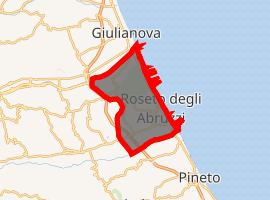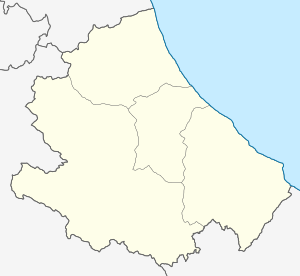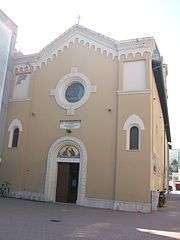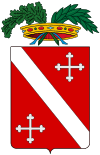Roseto degli Abruzzi
Roseto degli Abruzzi (Italian: [roˈzeːto deʎʎ aˈbruttsi]), more commonly Roseto, is a town and comune of the province of Teramo in the Abruzzo region of central Italy. It is a beach resort on the Adriatic Sea and has about 24,000 inhabitants. Geographically, Roseto is positioned on estuaries of the Vomano and Tordino Rivers. It is the second largest city in the province. In the last decade the city has witnessed a good deal of growth in the quarters of Borsacchio slightly to the north, Campo a Mare along the seacoast and Voltarrosto to the west.
Roseto degli Abruzzi | |
|---|---|
| Comune di Roseto degli Abruzzi | |
 Fountains on the "Roseto sea promenade" | |
Location of Roseto degli Abruzzi 
| |
 Roseto degli Abruzzi Location of Roseto degli Abruzzi in Italy  Roseto degli Abruzzi Roseto degli Abruzzi (Abruzzo) | |
| Coordinates: 42°41′N 14°1′E | |
| Country | Italy |
| Region | Abruzzo |
| Province | Teramo (TE) |
| Frazioni | see below |
| Government | |
| • Mayor | Sabatino Di Girolamo |
| Area | |
| • Total | 52 km2 (20 sq mi) |
| Elevation | 5 m (16 ft) |
| Population (30 May 2007)[2] | |
| • Total | 24,230 |
| • Density | 470/km2 (1,200/sq mi) |
| Demonym(s) | Rosetani |
| Time zone | UTC+1 (CET) |
| • Summer (DST) | UTC+2 (CEST) |
| Postal code | 64026 |
| Dialing code | 085 |
| Patron saint | Santa Maria Assunta |
| Saint day | 15 August |
| Website | Official website |
Geography
A major north–south rail line running along the coast passes through Roseto connecting it to the provincial capitals of Pescara and Teramo. Towns nearby include Atri, Giulianova, Morro d'Oro, Mosciano Sant'Angelo, Notaresco and Pineto. Roseto is a popular and highly developed seaside location known throughout Italy and the world. It is sometimes referred to as Lido delle Rose (Beach of the Roses). More recently it has been associated with the "Bandiera Blu" (The Blue Banner).
History

The name of the city was decreed to be Rosburgo by decree of King Umberto I of Italy in 1877. Later the name fell into disfavor, especially in military circles, because it sounded Austrian, a bitter enemy of Italy during World War I, and in 1927 the city was rechristened with its current name. The name derives in part from the large numbers and varieties of rose and oleander trees which grace the byways and balconies of the city's residents. Tourism is the main economical activity in terms of revenue generated. Roseto's coastline, including an area known as Cologna, has more than 10 kilometres (6 mi) of beaches available for swimming and other water activities.
Culture
Just as the name of the city was changed from Rosburgo to Roseto, Saint Mary of the Assumption took the place of Saint Filomena of Rome as the city's liturgical patroness. This followed an examination of the saint's remains, which found no trace of human blood but only a vial of perfume, rings, and various assorted personal items. The controversy this engendered led some to conclude that the remains were not those of Saint Filomena but rather those of another young woman who died in the 4th century AD.
Sports
In the sports domain Roseto is best known for its basketball team Roseto Basket. It hosts a large indoor stadium capable of seating 4,500 fans. Other popular sporting facilities include an Olympic size swimming pool, numerous tennis courts, futsal courts, and bocce courts.
Economy
Roseto is a communications center. Its economy is strengthened by the fact that it has a balance of both commercial and touristic entities. Rolli S.p.A., produces and exports a large quantity of jams, marmalade, and preserves. A large scale wine producer, Scialletti, exports internationally. Dozens of smaller concerns contribute to Roseto's industrial sector. Roseto is second only to Teramo in hosting artisan workshops and small factories. Many large trucking and transportation companies are located nearby.
Education
A Canadian school, Centro Scuola, has organized summer language programs in Roseto and neighbouring towns for many years. Beginning in the fall of 2004 semester-long programs have been conducted.
Frazioni
Frazioni (outlying areas) of this communal city include San Giovanni, Campo a Mare, Casal Thaulero, Cologna Paese, Cologna Spiaggia, Montepagano, Santa Lucia, Voltarrosto, and Bonaduce.
Twin towns


.svg.png)



See also
References
- "Superficie di Comuni Province e Regioni italiane al 9 ottobre 2011". Istat. Retrieved 16 March 2019.
- All demographics and other statistics: Italian statistical institute Istat.
